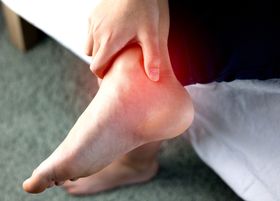Best Exercises and Stretches for Metatarsalgia Pain Relief
Discover simple, effective exercises and stretches to alleviate metatarsalgia pain and get back to pain-free walking
Updated July 29, 2025

You never really think about your feet—until they start screaming at you with every single step! Metatarsalgia, a condition marked by pain in the ball of the foot, can transform walking, standing, and even simple movements into an excruciating ordeal.
In this guide, we'll explore targeted exercises designed to alleviate pain and restore comfort to your feet.
» Don't let foot pain hold you back. Try our Custom Metatarsalgia Orthotics for relief
What Causes Metatarsalgia?
Metatarsalgia is a complex issue influenced by various factors. While high-impact activities like running and jumping can exacerbate the problem, it's not only something active people deal with. People with high arches, excess weight, or frequently wearing ill-fitting shoes are also at risk.
The mechanics of the foot play a crucial role. High arches can concentrate pressure on the metatarsal heads, while excess weight further burdens these tiny bones. Even seemingly minor choices, such as wearing high heels or poorly cushioned shoes, can contribute to the development of metatarsalgia.
» Explore possible causes of forefoot pain. Is it metatarsalgia?
Why Targeted Exercises Can Help
Exercise isn't just about managing pain—it's about restoring your foot's natural strength and flexibility. When you perform specific stretches and movements, you're essentially giving your feet a comprehensive rehabilitation program.
These exercises improve blood circulation, bringing healing nutrients to damaged tissues, reducing inflammation, and promoting recovery.
Each intentional movement works to:
- Expand the range of motion in ankle, foot, and knee joints
- Recalibrate muscle coordination
- Improve overall balance and proprioception
- Realign gait mechanics to prevent future compensatory movements
» Learn more about how to reduce swelling and relieve metatarsalgia
Essential Stretches for Metatarsalgia
Stretching goes beyond simple flexibility. It helps reset muscle tension, improve joint mobility, and create a more balanced weight distribution across your foot. Try these effective stretches.
1. Toe Pumps
This gentle exercise helps improve toe and foot mobility:
- Sit comfortably and prop your foot on its heel
- Bend and extend your toes while moving your foot slightly back and forth
- Perform 20 repetitions for 2–3 sets
2. Toe Flexor Stretch
Targeting the bottom of your foot:
- Sit in a chair and place the affected foot on your opposite knee
- Use your hand to bend your toes towards your shin gently
- Hold the stretch for up to 30 seconds
- Repeat 15–20 times for 2–3 sets
» Want more relief? Try these foot massages for relief
3. Sitting Calf Stretch
Helps loosen the ankle and calf muscles:
- Sit with a stretch strap or towel under the ball of your foot
- Keep your knee straight and pull your toes towards your shin
- Hold for 30 seconds and relax
- Repeat up to 5 times per leg for 2–3 sets
» Check out the benefits of rolling out your feet for reducing foot pain
Strengthening Exercises for Metatarsalgia
These exercises help build a supportive foundation, reducing stress on the metatarsal heads. But it's important to tailor your routine based on your pain and fitness levels.
Stick to low-impact exercises and always wear well-fitting shoes to reduce further stress. Remember to avoid direct pressure on the painful areas during exercises.
1. Toe Raises
Builds foot strength and stability:
- Stand near a chair or wall for support
- Gradually lift your heels, transferring weight to the ball of your foot
- Lower back down slowly
- Perform 10–15 repetitions for 2–3 sets
- As you gain strength, try performing on one leg
» Tired of aching feet? Custom orthotics can provide the relief you need
2. One-Leg Stance
Improves balance and foot strength:
- Stand near a wall or chair
- Shift weight to one foot and lift the other off the ground
- Hold the position for 3–60 seconds
- Alternate legs and repeat 2–3 times
3. Towel Scrunches
Engages foot muscles:
- Place a towel on the floor
- Using your toes, scrunch the towel towards you without lifting your heel
- Complete three sets of 15 repetitions for each foot
» Understand the treatment timeline for metatarsalgia
Tired of Toe Pain? Discover the Secret to Relief
Metatarsalgia can be a persistent and frustrating condition, but it's possible to manage symptoms and improve your quality of life. By listening to your body and including these strategies into your daily routine—plus rest and ice therapy—you can reduce inflammation and alleviate pain.
While exercises can help, they may not always address the root cause of the pain, especially if it's related to footwear. For a targeted solution, consider Upstep's Metatarsalgia Custom Orthotics. Designed to fit any shoe, they provide personalized support, redistributing pressure and correcting biomechanical imbalances.
Rediscover comfort and pain-free movement with Upstep's orthotics. By treating the root cause of your foot pain, you can get back to doing what you love, without worrying about your feet!
Disclaimer: The information on this blog is for educational purposes only and is not a substitute for professional medical advice. Upstep does not provide medical diagnosis or treatment. While qualified podiatrists create our content, it's essential to consult with your healthcare provider for any foot or ankle concerns you may have.








